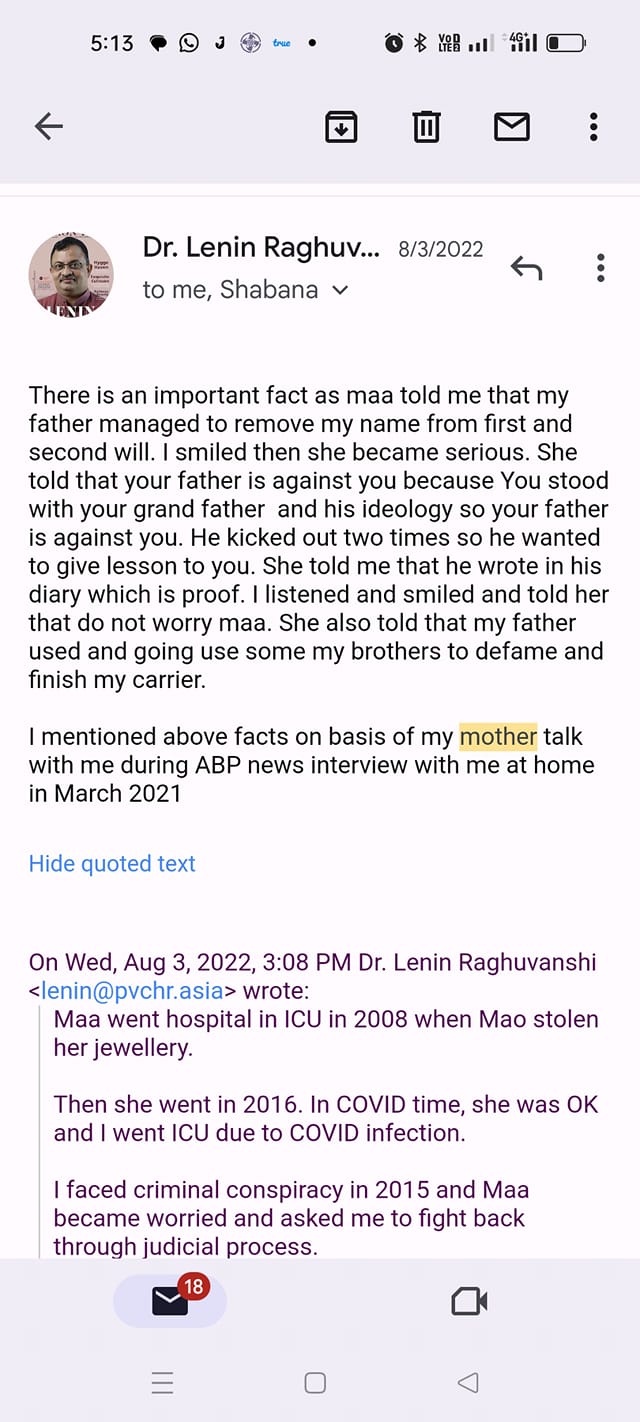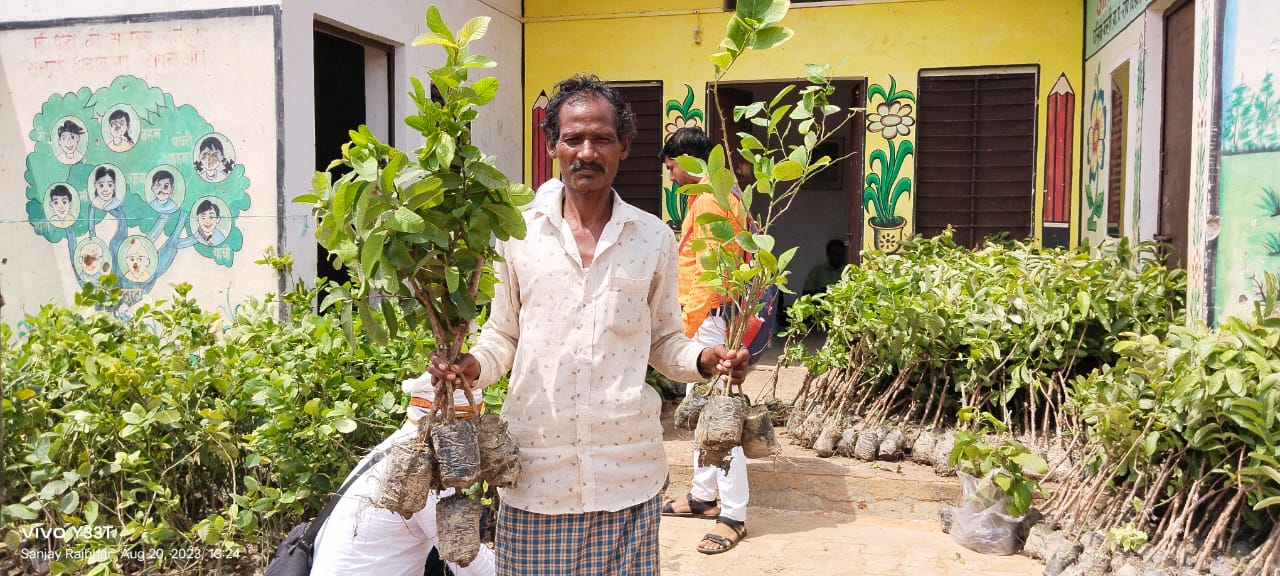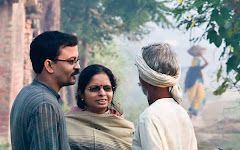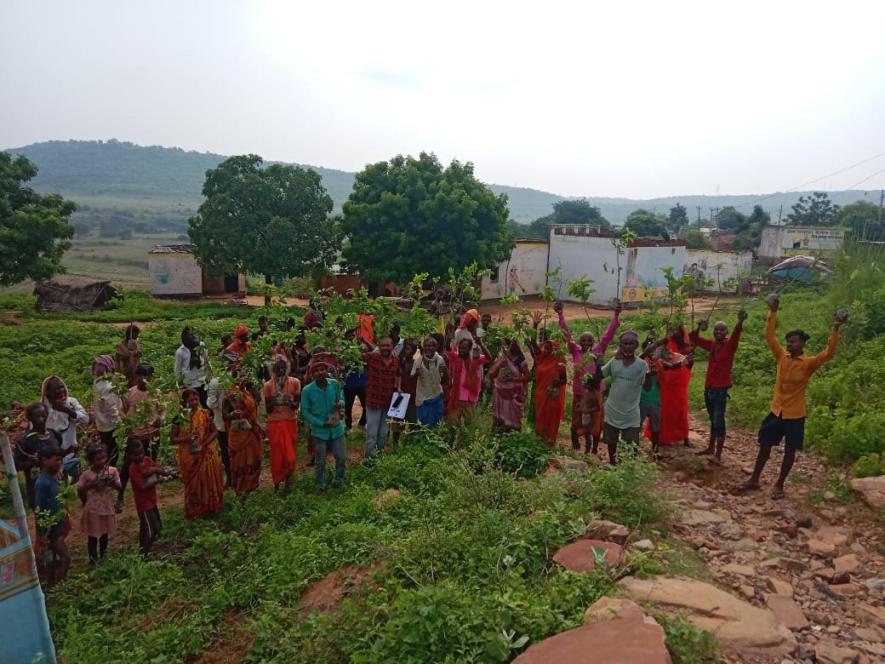
कली का दो वर्षीय बेटा शिव कुपोषित है। बेहद दुबला-पतला। ऐसा लगता है जैसे शरीर में खून ही नहीं है। वो मुश्किल से बैठ पाता है। कली के पांच बच्चे हैं, जिनमें शिव सबसे छोटा है। मां-बेटे की आंखों में एक अलग बेबसी और उदासी दिखती है। खेतों में मेहनत-मजूरी करने वाली कली को अपने अधिकारों के बारे में इतना पता नहीं है। उन्हें स्वास्थ्य, शिक्षा, अधिकार, विकास और लोकतंत्र जैसे शब्द भी ज़्यादा समझ नहीं आते हैं।
कली यूपी के सोनभद्र के जिला मुख्यालय राबर्ट्सगंज से सटे रौप गांव के घसिया बस्ती की रहने वाली हैं। करीब छह सौ की आबादी वाली यह बस्ती शहर से करीब ढाई किमी के फ़ासले पर है। घसिया बस्ती में रहने वाला हर आदिवासी करमा नृत्य का फनकार है। इसके बावजूद इनके जीवन भर की कुल मिल्कियत है एक चारपाई, जिसकी पट्टियां लकड़ियों को जोड़कर तैयार की गई हैं। तहां-तहां रस्सी पर फैली कुछ रंग-बिरंगी पालिस्टर की साड़ियां, पानी के कुछ डिब्बे, दड़बेनुमा मकान के कोने में रखीं एक-दो बोरियां और मैले-कुचैले फटे हुए बिस्तर। अगर उनके लिए कोई चीज़ हमेशा थमी रही है तो वो है विकास।
घसिया बस्ती के लोग उस डरावने और शर्मनाक सच को आज तक नहीं भूल पाए हैं जब दो दशक पहले मुट्ठी भर चावल नसीब नहीं होने के कारण भूख और कुपोषण से18 बच्चों की मौत हो गई थी। यह मामला अखबारों की सुर्खियां बनीं तो सरकारी नुमाइंदे घसिया बस्ती की ओर दौड़े। सर्वे हुआ तो 43 कुपोषित बच्चों की शिनाख्त हुई।
दिल्ली और लखनऊ में सत्ता के गलियारों में घूमते हुए जो लोकतंत्र दिखता है, उससे बहुत अलग-सी तस्वीर घसिया बस्ती में दिखती है। दुनिया के सबसे बड़े लोकतंत्र की तस्वीर। बेहद कमज़ोर दिखने वाले शिव और उसकी मां की बेबसी की सच्ची तस्वीर। ऐसी तस्वीर अकेले कली और शिव की नहीं है। पूर्वांचल के सोनभद्र, मिर्जापुर और चंदौली के नौगढ़ इलाके में हज़ारों आदिवासी परिवार इसी हालात में जीने के लिए मजबूर हैं।
भूखे से मरने वालों का स्मारक
राबर्ट्सगंज-सिगरौली राजमार्ग पर बसी है घसिया बस्ती। इस बस्ती में आने-जाने का कोई रास्ता नहीं है। बस एक पगडंडी भर है जहां से आदिवासी आते-जाते हैं। उत्तरी छोर पर एक आंगनबाड़ी केंद्र चलता है। मानवाधिकार की लड़ाई लड़ने वाली संस्था पीपुल्स विजिलेंस कमेटी फॉर ह्यूमन राइट्स ने साल 2014 में बनारस के पत्रकार स्व. सुशील त्रिपाठी के नाम पर यहां स्कूल खोला और नलकूप भी लगवाया। अब इसकी देख-रेख सरकार कर रही है। स्कूल में आंगनबाड़ी केंद्र चलाया जा रहा है। इससे दस कदम आगे बढ़ते ही एक अनूठा शहीद स्मारक दिखता है, जिस पर भूख से मरने वाले बच्चों के नाम लिखे गए हैं।
भारत में आमतौर पर विकास और जनसेवा को तस्दीक करने के लिए सरकारें युग पुरुषों का स्मारक बनाती रही हैं। लेकिन घसिया बस्ती में भूख से मरने वाले बच्चों का स्मारक एक अनकही हक़ीक़त को बेपर्दा करता है। इस शहीद स्मारक पर पुन्नू, रोशन, विजमल, लालमोहन, प्रीति, जीऊत, धीमाल, फूल सिंह, दीपक, सोमारू, रवैरी, जीरावती, सारांश, विमली, रामकरन, रामगोविंद, कविता, कुवारा के नाम दर्ज हैं।
20 जनवरी 2007 को एशियन ह्यूमन राइट्स कमशीन हांगकांग के अधिशासी निदेशक वासिल फर्नांडो और बाल कवि तुमुल ने इस स्मारक का उद्घाटन किया था। भूख से तड़प-तड़प कर जाने देने वाले ज़्यादातर बच्चों की उम्र दो से चार साल थी। घसिया बस्ती में भूख से मौतों को सिलसिला साल 2001 से शुरू हुआ। एक-एक करके 18 बच्चे मर गए। प्रशासन की नींद बहुत बाद में खुली, लेकिन राहत के नाम पर आदिवासियों को कुछ भी मयस्सर नहीं हुआ।
सरकार के माथे पर कलंक का टीका लगाने वाले इस शहीद स्मारक के चबूतरे बैठे मिले दो बच्चे। एक की उम्र करीब दस और दूसरे की करीब डेढ़ बरस थी। दोनों भाई थे। इनके हाथ में बिस्कुट के छोटे-छोटे पैकेट थे। दोनों बच्चे आने-जाने वालों को एकटक निहार रहे थे। स्मारक पर जिन बच्चों का नाम लिखा था, उनमें से एक नाम दीपक का है, जिसकी मौत फकत छह साल में भूख से हो गई थी। दीपक घसिया टोला के सुक्खन का बेटा था, जो पिछले चुनाव में निर्विरोध पंचायत सदस्य चुने गए थे।
सुक्खन बताते हैं, "हम लोक कलाकार हैं। करमा लोकनृत्य का एक कार्यक्रम पेश करने बस्ती से बाहर गए थे। नाच-गाने से ही हमारी आजीविका चलती थी। घर में बच्चों के खाने के लिए कुछ नहीं था। दोनों वक्त की रोटी का इंतजाम करने के लिए हमें प्रोग्राम के लिए जाना पड़ा। हमारे पहुंचने से पहले मेरे बेटे दीपक की भूख से मौत हो गई थी। तंगहाली के चलते बेटे के शरीर में ख़ून की कमी और कमज़ोरी हो गई थी। सिर्फ शरीर का ढांचा था। हम जिस प्रोग्राम में गए थे वहां से भी हमें पैसे नहीं मिले। हम बहुत लाचार थे। पैसे से गए और बच्चे के ज़िंदगी से से भी।"
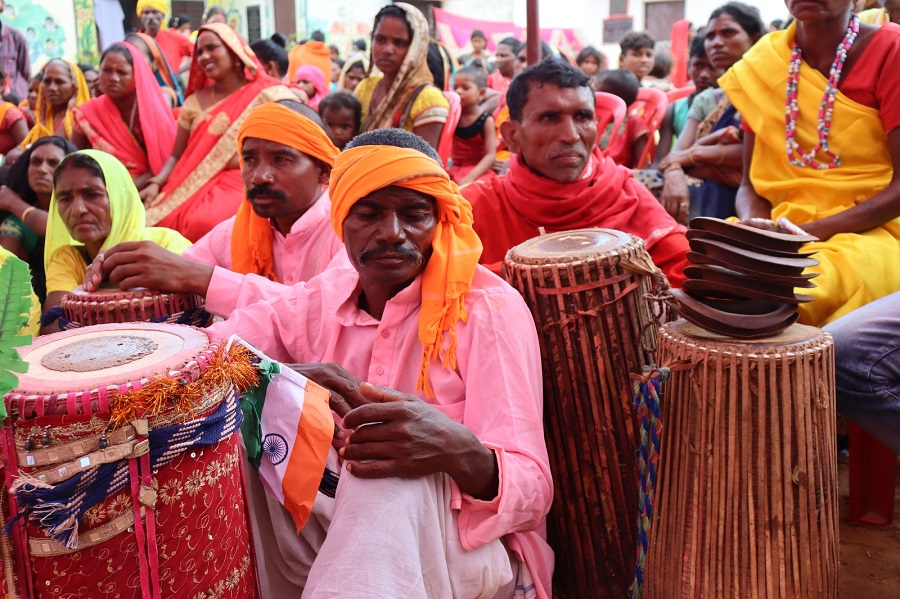
घसिया बस्ती में आज भी तमाम बच्चे कुपोषण की ज़द में हैं। महिलाओं में खून की कमी है। यहां रहने वाले आदिवासी आज भी पानी जैसी बुनियादी सुविधाओं के लिए तरस रहे हैं। बगैर स्कूल, स्वास्थ्य सेवा और रोज़गार के घसिया बस्ती ‘सबका साथ-सबका विकास’ जैसे नारों को सुनकर चौंक रही है। लोकतंत्र और नागरिक अधिकार जैसे शब्द यहां बौने नज़र आते हैं।
पंचायत सदस्य सुक्खन और रामवृक्ष एक स्वर में कहते हैं, "हम बीस बरस से पानी के लिए दौड़ रहे हैं। पीने का पानी गांव से गुज़रने वाली एक पाइप की छेद से निकलता है, जहां दिन भर डिब्बा लिए औरतों और बच्चों की कतारें लगी रहती हैं। बिजली का खंभा गिर गया है, जिससे घसिया बस्ती अंधेरे में डूबी है। यहां मच्छरों का बड़ा आतंक है। बस्ती में हर समय चार-छह लोग मलेरिया बुखार का इलाज करा रहे होते हैं।"
लोक कलाकार आशा कहती हैं, "हर चुनाव में नेता आते हैं। वो हमें बहला-फुसलाकर वोट ले लेते हैं। गाहे-बगाहे अफसर भी आते है। हमें तरक्की का सपना दिखाते हैं। जब हम उनके दफ्तर में जाकर रोज़गार और सुविधाएं मांगते हैं तो वहां अपमान के सिवाय कुछ नहीं मिलता। सच कहूं तो आजकल के पढ़े-लिखे बहुत कम लोग वादा पूरा करते हैं। नेता और अफसर तो केवल फुसलाते हैं, झूठा आश्वासन देते और चले जाते हैं। यही सिलसिला सालों से चल रहा है।"
कलाकारों की बस्ती
घसिया बस्ती कोई मामूली बस्ती नहीं है। यह आदिवासियों की वह बस्ती है जहां के लोग राष्ट्रीय स्तर के सांस्कृतिक आयोजनों में करमा नृत्य करने जाते हैं। इस गांव के कलाकार पूर्व प्रधानमंत्री राजीव गांधी, राष्ट्रपति शंकर दयाल शर्मा समेत तमाम दिग्गज नेताओं के साथ सत्ता के गलियारों में लंच और डिनर कर चुके हैं। 24 नवंबर 1986 को कांग्रेस की वरिष्ठ नेत्री श्रीमती सोनिया गांधी के भोज के निमंत्रण पर उनके आवास पर घसिया बस्ती की फनकार रुकमनिया के साथियों ने अपना पारंपरिक करमा नृत्य पेश किया था। यहां के तमाम आदिवासी फनकारों ने जहाज से भी यात्राएं की हैं। ये कलाकार देश के कई हिस्सों, आकाशवाणी और दूरदर्शन केंद्रों, नाट्य अकादमियों पर मंचीय प्रस्तुतियां दे चुके हैं। साल 2001-02 में पोर्टब्लेयर (अंडमान-निकोबार) में आयोजित आईलैंड फेस्टिवल में घसिया बस्ती के 16 कलाकारों ने हिस्सा लिया था।
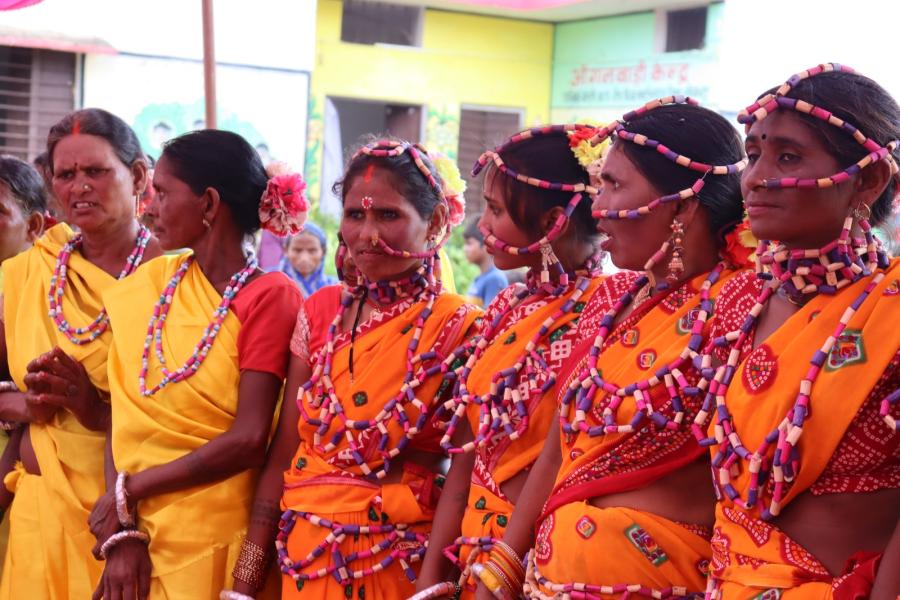
घसिया बस्ती में सुक्खन, गजाधर, आशा, रामवृक्ष, नरेश, संतोष, महेंद्र, कतवारू, रामधनी आदि करमा, झूमर, शैला, गोंडवानी, धावा, डामकच आदि के विधाओं में निपुण फनकार हैं। इनके अस्तित्व की लड़ाई आज भी जारी है।
झूमर नृत्य की फनकार दुलारी बताती हैं, "पहाड़ों में झरनों का संगीत सुनकर हमारे पैर अपने आप थिरकने लगते थे। पहाड़ों पर खिले पलाश के फूल होठों पर गीत रचने लगते थे। पुलिस प्रशासन हमें ठीक से न जीने देता है, न रहने देता है और न काम करने देता है। वो अक्सर कलाकारों के माथे चोरी का झूठा तमगा चस्पा कर देता है।"
घसिया बस्ती में हमारी मुलाकात चर्चित आदिवासी कलाकार गजाधर घसिया से हुई। हमने पूछा कि लोकसभा चुनाव आने वाला है। बिजली-पानी का मुद्दा उठाइए? इस पर गजाधर कहते हैं, "हम सालों से चुनाव देख रहे हैं। मतदाता जागरूकता अभियान चलाने के लिए प्रशासन हमारा इस्तेमाल करता है। पिछले साल हमारे गांव में करमा नृत्य से जुड़ी तीन टीमें तैयार की गई हैं। हमने विधानसभा वार मतदाता जागरूकता अभियान में नृत्य प्रस्तुत किया और लोगों को अधिक से अधिक मतदान के लिए प्रोत्साहित किया। मतदाता जागरूकता के नाम पर हमसे बहुत बेगारी कराई गई। हमारी कला पर सभी वाह-वाह करते हैं, लेकिन हम लोगों की सुनवाई कहीं नहीं होती। हम कलाकार हैं, पर दाने-दाने को मोहताज हैं। तमाम कार्यक्रमों का पैसा बकाया है। हमारे घरों की औरतों का गहना-गुरिया सब गिरवी है। बच्चे भूख से बिलबिला रहे हैं। हम भी ऐसे कब तक जिएंगे। हम क्या खाते हैं, कैसे जीते हैं और कैसे मरते हैं, यह सिर्फ हम जानते हैं।"
"घसिया बस्ती के लोक कलाकारों की हर टीम को एक प्रोग्राम के लिए75 हज़ार से एक लाख रुपये तक मिलते हैं। अफसरों को कमीशन और रिश्वत देने के लिए हमारे पास पैसे नहीं हैं। आदिवासी कलाकारों का ढेरों पैसा कई राज्यों की सरकारें दबाकर बैठी हुई हैं। हमें नहीं लगता है कि सरकारें हमारे हुनर और मेहनत का भुगतान आसानी से करेंगी। सरकार है कि वो हमारे हालात को समझती ही नहीं। वह तो यह भी नहीं समझती कि ग़रीबी आखिर होती क्या है?"

बहुत दर्दनाक है दिग्गज कलाकार गजाधर की कहानी
आदिवासी करमा नृत्य के दिग्गज कलाकार गजाधर की दर्दनाक कहानी घसिया बस्ती के करीब तीन सौ घरों की सच्चाई है। इस बस्ती के कुछ लोग ढोलक और झाड़ू बनाते हैं और कुछ मेहनत-मजूरी करके गुज़र-बसर करते हैं। इनकी सामाजिक और आर्थिक हालत दिन-प्रतिदिन खराब होती जा रही है। घसिया बस्ती में सरकारी सुविधाओं के नाम पर जो भी हैंडपंप लगे हैं वो डीप बोरिंग नहीं होने की वजह से शो-पीस बने हुए हैं। एक आंगनबाड़ी केंद्र है, जिसे गांव के लोगों ने समाजसेवी संगठन पीपुल्स विजिलेंस कमेटी फॉर ह्यूमन राइट्स के सहयोग से बनाया है। वहां आंगनबाड़ी कार्यक्रम चल रहा है।
घसिया बस्ती के आदिवासियों के उत्थान के लिए पिछले दो दशक से काम कर रहीं एक्टिविस्ट श्रुति नागवंशी कहती हैं, "यहां औरतों के साथ पुरुष भी सुरक्षित नहीं हैं। महिलाओं को अपनी आबरू की चिंता रहती है तो पुरुषों को हमेशा झूठे मुकदमें में फंसाए जाने का खौफ सताता रहता है। पुलिस अथवा किसी अफसर की गाड़ी देखते ही इस बस्ती के बच्चे और नौजवान छिपने लगते हैं। प्रशासन इनके साथ दोयम दर्जे का व्यवहार कर रहा है। एक तरफ सरकारी वेबसाइटों पर इन्हीं आदिवासी कलाकारों के करमा नृत्य को बढ़ावा दिया जा रहा है। इनके हुनर को भारतीय संस्कृति बताकर दुनिया भर में प्रचारित किया जा रहा है। दूसरी तरफ इन कलाकारों के साथ मुजरिमों जैसा व्यवहार किया जा रहा है। ऐसे में इन कलाकारों का हुनर लंबे समय तक ज़िंदा रह पाएगा, यह कह पाना बेहद कठिन है।"
जंगलों में रहने वाले करमा आदिवासियों ने करीब दो-ढाई दशक पहले निछद्दम स्थान पर अपना डेरा बनाया था। उनके पास सिर्फ खास-फूस की झोपड़ियां हुआ करती थीं। वो भूख और ग़रीबी की मार झेल रहे थे। काम खोजने के लिए दर-दर भटकते, रोटी और इलाज के लिए घसिया आदिवासी यहां आए। मौजूदा समय में इनके हालात बहुत बदल गए हैं। इनकी जो स्थिति है, वो बहुत ज़्यादा दर्दनाक है। जंगलों में लौट जाने का विकल्प इनसे छीना जा चुका है। इन्हें सुविधाएं मयस्सर नहीं हैं, जिसके लिए वो लगातार संघर्ष कर रहे हैं। घसिया बस्ती के युवाओं के पास रोज़गार गारंटी कार्ड है, लेकिन उस कार्ड पर उन्हें आज तक कोई काम नहीं मिल सका है। ज़िले के प्रशासनिक अफसरों से इस बारे में पूछे जाने पर वो कहते हैं कि आदिवासियों ने काम मांगा ही नहीं होगा, इसीलिए नहीं मिला।
आदिवासी रामसूरत की गृहस्थी झुलसती नज़र आती है। वह लोक कलाकार है। कहते हैं, "हमारे पास घर नहीं है। अगले चुनाव में हम उसी को वोट देंगे, जो आवास और रोज़गार की गारंटी देगा। साथ ही घसिया बस्ती को सांस्कृतिक गांव घोषित कराने का पुख्ता वादा करेगा।" राममूरत को यह नहीं पता कि अगला चुनाव दिल्ली के लिए है अथवा लखनऊ के लिए। उनके मन में बस एक छोटी-सी उम्मीद है कि कभी तो कोई नेता आएगा और उसकी सुध लेगा, तब शायद लोकतंत्र की छाव उनके गांव पर पड़ेगी। सोनभद्र के आदिवासियों के एक छोटी-सी बस्ती की यह छोटी-सी कहानी है। ऐसी कहानी जिसमें अगर कुछ है तो वो है जीने की जद्दोजहद और आदिवासी कलाकारों की ढेरों दुशवारियां।
"छत ही नहीं पानी भी मयस्सर नहीं"
सोनभद्र के जनजातियों के उत्थान के लिए पिछले दो दशक से काम कर रहे एक्टिविस्ट डॉ. लेनिन कहते हैं, "घसिया आदिवासी किसी तरह खुद को ज़िंदा रखने के लिए संघर्ष कर रहे थे। इन्हें भीख तक मांगने से रोका जाने लगा। इसी के साथ घसिया बस्ती में शुरू हो गया भुखमरी का दौर। साल 2001 से 2002 के बीच एक के बाद एक करके बच्चे मरते चले गए। हमने राष्ट्रीय मानवाधिकार आयोग से शिकायत की। आयोग ने इसे महत्वपूर्ण मामला मानते हुए यूपी के मुख्य सचिव को नोटिस भेजा। इसके बाद राशन और कुछ सुविधाएं मिलनी शुरू हुई। मौजूदा समय में इनकी झोपड़ियां कच्चे घरों में बदल चुकी हैं, लेकिन किसी को प्रधानमंत्री आवास आज तक नहीं मिल सका है।"
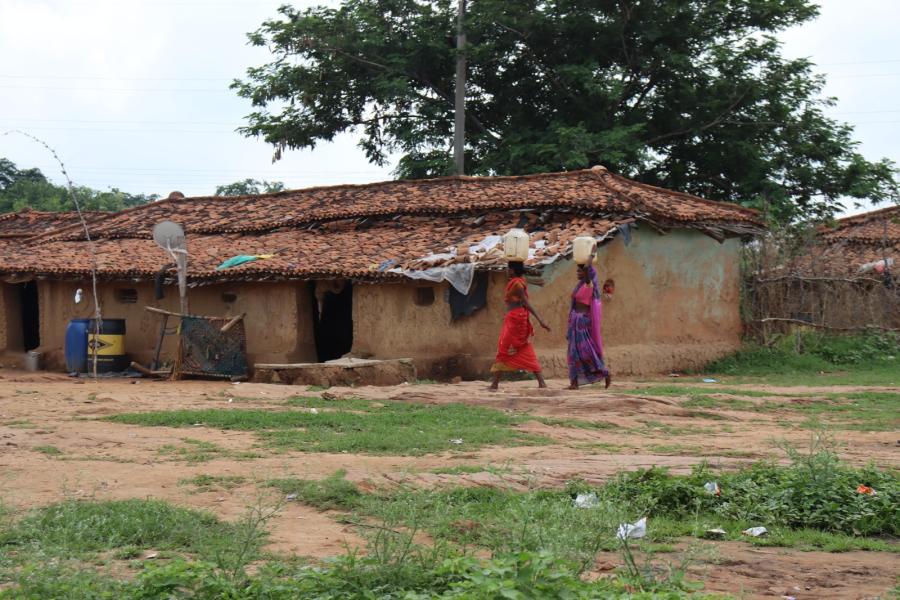
"यह सच किसी के मन में हलचल मचा सकता है कि घसिया बस्ती के कुछ लोग आज भी चकवढ़ (जंगली घास) की सब्जी और महुआ-सरई खाकर ज़िंदा रहते हैं। आदिवासियों को हम आर्थिक संबल देने की कोशिश कर रहे है। इंडो-जर्मन सोसाइटी की सुश्री हेल्मा रिचा के आर्थिक सहयोग से हमने आदिवासियों को तीन हज़ार फलदार पौधे बांटे हैं, जिनमें अमरूद, नींबू, मोरिंगा, सागवान (सागौन) और बांस के पौधे लगवाए गए हैं। हम घसिया बस्ती के बच्चों को कुपोषण से मुक्ति दिलाना चाहते हैं। राबर्ट्सगंज में जिस स्थान पर घसिया बस्ती है वह सरकारी अभिलेखों में खेल के मैदान के रूप में दर्ज है। प्रशासन का दावा है कि आदिवासी दो दशक से उस ज़मीन पर क़ब्ज़ा किए हुए हैं। हमने सरकार को चिट्ठी लिखी कि अगर उनका क़ब्ज़ा पुराना है तो वह ज़मीन उन्हें पट्टा कर दीजिए। बड़ा सवाल यह है कि इस बस्ती के आदिवासियों को जब शौचालय और हैंडपंप मिल सकता है तो आवास क्यों नहीं?"
डा.लेनिन कहते हैं, "घसिया जनजातियों ने अपनी गरिमा को दोबारा हासिल करने के लिए अपनी संस्कृति को फिर से जागृत करना शुरू कर दिया है। उन्होंने पर्यावरण को बहाल करने के लिए एक बड़ी यात्रा शुरू की है। कुपोषण से मुक्ति पाने के लिए बस्ती के हर परिवार ने अमरूद और नीबू के दस-दस पेड़ रोपा है।"
"घसिया बस्ती के आदिवासी पिछले दो दशक से घोर निराशा में डूबे हुए हैं। खासतौर पर तब से जब जरगो बांध बनाने के लिए उनके पैतृक घरों को जबरिया उखाड़ फेंका गया। इसके बावजूद उन्होंने अपनी जीवंत संस्कृति और सभ्यता को बचाए रखा, जो मास्टर कलाकारों और नर्तकियों के कौशल, कर्म और झूमर जो नए सिरे से चित्रित करता नज़र आता है।"
"पत्रकारिता कम, वकालत ज़्यादा"
राबर्ट्सगंज की मूल निवासी दिल्ली की वरिष्ठ पत्रकार इंदू पांडेय कहती हैं, "पांच किलो चावल से सोनभद्र के आदिवासी बहुल इलाकों में भुखमरी पर क़ाबू ज़रूर हो गया है, लेकिन भूख पर नहीं, क्योंकि सिर्फ़ चावल से ही शरीर को उतना पोषण नहीं मिल जाता जिसकी ज़रूरत है। यह कहा जा सकता है कि सरकार ने एक रुपये की दर से चावल देकर भूख पर एक तरह की चादर डाल दी है। एक ऐसा परदा जिससे भुखमरी दिख नहीं रही है, लेकिन आदिवासियों की भूख अभी ख़त्म नहीं हुई है। आदिवासियों को कुछ सरकारी स्कीमों के भरोसे छोड़ दिया गया है। इनके रोज़गार के अवसर की बात नहीं हो रही है, जिससे बड़े पैमाने पर पलायन हो रहा है। सोनभद्र के आदिवासियों के पास काम नहीं है। उनके मन में अनगिनत घाव हैं जो सत्ताधीशों को नहीं दिख रहे हैं। अच्छी बात यह है कि घसिया बस्ती में अब भूख से मरने की खबरें नहीं आतीं।"
इंदू यह भी कहती हैं, "सोनभद्र की घसिया बस्ती कलेक्ट्रेट से सटी है, जिसमें सभी परिवार आदिवासी हैं। इनकी दुश्वारियों को खबरनवीशों ने आज तक समझने की कोशिश ही नहीं की। इनके मन को पढ़ने के लिए न नेता तैयार हैं, न सरकार और न ही नौकरशाही। पत्रकारों की तो बात ही छोड़ दीजिए। यहां खबर कारीगरों का एक बड़ा तबका समूची घसिया बस्ती को शराबी और अपराधी मानता है। खासतौर पर सोनभद्र का मीडिया आदिवासियों के मामलों में जज की भूमिका में दिखता है। प्रकृति की दुश्वारियां झेल रहे पहाड़ी इलाकों में तो वह पत्रकारिता से अधिक वकालत करने लगा है, जिसके चलते समाज का आखिरी आदमी न्याय के लिए तड़प रहा है।"
सोनभद्र जिले में घसिया आदिवासियों की तादाद करीब 60 हज़ार से ज़्यादा है जो गांवों में छिटपुट तौर पर रहते हैं। वो मूलभूत बुनियादी सुविधाओं से वंचित हैं। इनके ज़्यादातर बच्चे स्कूल नहीं जाते। बहुत से लोगों को आज भी कई बार खाली पेट सोना पड़ता है, क्योंकि वो दिन में दो वक्त के भोजन की व्यवस्था नहीं कर पा रहे हैं। बीपीएल परिवारों की मासिक आमदनी सात-आठ सौ रुपये से भी कम है।
बीपीएल जनगणना 2002 की संपूर्ण सर्वेक्षण रिपोर्ट तो बहुत कुछ कहती है। रिपोर्ट के मुताबिक, ऊर्जांचल के 04 हज़ार 633 परिवारों को हर रोज एक बार से कम भोजन मिलता है। चंदौली और मिर्जापुर में ऐसे परिवारों की संख्या क्रमशः 716 और 45,952 है। इसी तरह चंदौली में 10,241 बीपीएल परिवार, सोनभद्र में 4,176 और मिर्जापुर में 1,832 परिवार 250 रुपये से कम मासिक आय में अपनी सभी ज़रूरतें पूरी करते हैं।
"छीने जा रहे आदिवासियों के अधिकार"
एक्टिविस्ट एवं अधिवक्ता आशीष पाठक कहते हैं, "सोनभद्र को एनटीपीसी और दूसरे थर्मल पावर प्लांटों के साथ बिजली के एक बड़े हब के रूप में जाना जाता है। इससे सटा चंदौली इलाका धान के कटोरे के रूप में मशहूर है। इसी तरह मिर्जापुर बलुआ पत्थर और कालीन उद्योग के लिए विश्वविख्यात है। पूर्वांचल के तीनों ज़िलों में आदिवासियों की आठ जातियां रहती हैं जिनमें कोल, खरवार, भुइया, गोंड, ओरांव या धांगर, पनिका, धरकार, घसिया और बैगा हैं। ये लोग जंगलों से तेंदू पत्ता, शहद, जलावन लकड़ियां, परंपरागत औषधियां इकठ्ठा करते हैं और इसे स्थानीय बाज़ार में बेचकर अपनी रोज़ी-रोटी का इंतज़ाम करते हैं। कुछ आदिवासियों के पास ज़मीन के छोटे टुकड़े भी हैं, जिन पर धान अथवा सब्ज़ियों की खेती से अपनी ज़िंदगी गुज़ारते हैं।"
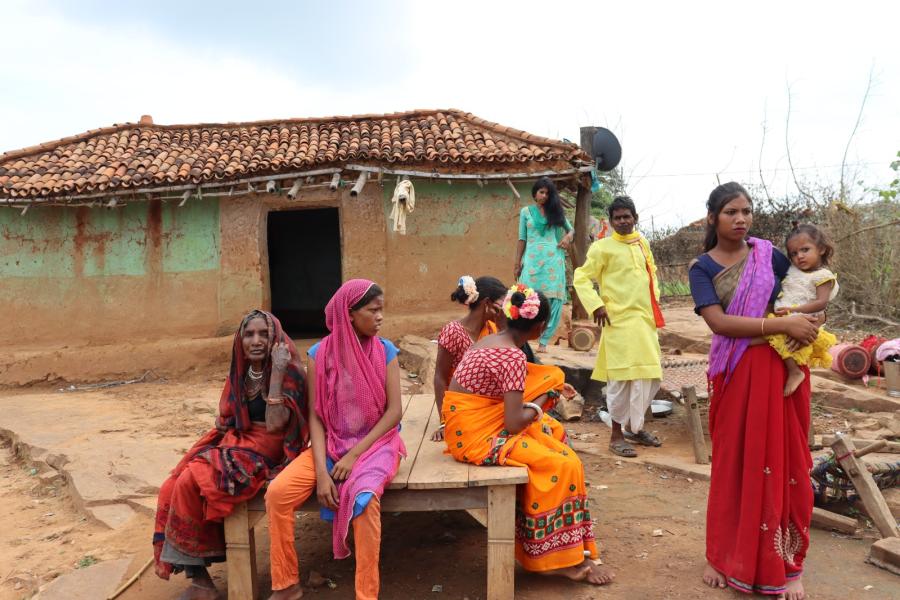
"सोनभद्र और मिर्जापुर की तुलना में चंदौली में स्थिति बेहतर है। पिछले दो दशक में आदिवासियों की स्थिति थोड़ी बदली है, लेकिन उनकी माली हालत बहुत अच्छी नहीं है। मौजूदा समय में अपनी रोज़ी-रोटी का इंतज़ाम करने का बेतरतीब तरीक़ा इनकी ज़िंदगी को समझने के लिए मजबूर करता है। गौर करने की बात यह है कि साल 2020 की ग्लोबल हंगर इंडेक्स रिपोर्ट में भारत 94वें स्थान पर था, लेकिन साल 2021 में हमारा देश 101वें स्थान पर पहुंच गया। चिंताजनक बात ये है कि भुखमरी के मामले में भारत अब बंगलादेश, पाकिस्तान और नेपाल से भी नीचे है।"
जनवादी नेता अजय राय कहते हैं, "सोनभद्र, चंदौली और मिर्ज़ापुर के जिन जंगलों में आदिवासियों का बसेरा था, उसे मुहिम चलाकर मिटाया जा रहा है। जब इन्हें खदेड़ा जाने लगा तो वन माफिया ने घुसपैठ शुरू कर दी। यह सब सुनियोजित ढंग से किया जा रहा है। वन क़ानून में नया संशोधन नियम-2022 लाकर मोदी सरकार ने अंग्रेज़ी हुकूमत को भी पीछे छोड़ दिया है। अब सरकार भी अंग्रेज़ों की तरह काम कर रही है। दुर्भाग्य की बात यह है कि आज़ादी के बाद से जंगलों में रहने वाले आदिवासियों को अपने अधिकारों के लिए लगातार लड़ना पड़ रहा है। भाजपा सरीखे सियासी दल आजकल आदिवासियों को हिंदू बताते घूम रहे हैं? अंदरखाने में झांकेंगे तो जवाब मिलेगा कि यह सारी कवायद सिर्फ वोटों के लिए हो रही है। सभी राजनीतिक दल इनका सियासी इस्तेमाल करना चाह रहे हैं। सभी दलों के नेताओं को पता है कि मौजूदा दौर में आदिवासियों की दस करोड़ की सघन आबादी अगले लोकसभा चुनाव में सियासत का रूख बदलने की भूमिका में है।"
(लेखक बनारस स्थित वरिष्ठ पत्रकार हैं।)




